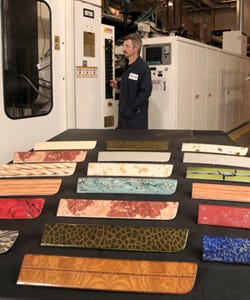

TROY, MI – Each year, IAC Group North America purchases about 300 million lbs. (136 million kg) of raw materials to produce plastic automotive interior components and trim.
But in recent years, the auto supplier increasingly has pursued the do-it-yourself route, developing its own raw-material compounds to meet customer or product-performance specifications.
“We’re one of the very few Tier 1 suppliers capable of vertically integrating our own materials, and it is to resolve some of the issues we have with some of the on-the-shelf materials the typical materials suppliers would sell to us,” says Rose Ryntz, IAC’s director-advanced engineering material development.
IAC estimates it produces 90 million lbs. (41 million kg) of compounded raw material a year, meeting a quarter of its needs internally.
The supplier has six compounding facilities in North America, and the materials then are molded into door panels, air ducts, consoles and cargo bins.
IAC is a relatively new supplier, assembled between 2006 and 2007 from pieces of Lear Corp., Textron Automotive Co. and the former Collins & Aikman Corp.
It was about that time the company decided to vertically integrate its own materials expertise as a strategic plan moving forward, says Maurice Sessel, vice president-engineering. A staff of chemists supports the initiative. Ryntz, for instance, has a Ph.D. in polymer/organic chemistry.
The company has produced its own unique plastics from polyvinyl chloride, rubber and thermoplastic olefin.

DeepClear allows image on paper to be molded and capped with protective acrylic.
“We started doing it because we couldn’t meet the need for a particular door application” with product already purchased, Ryntz says. “Or it had lighter weight vs. the competitive material for an instrument-panel application.”
In the course of developing new products for market, IAC has found several failures attributed directly to materials that had been purchased and did not meet performance specifications, says Lee Childers, vice president-advanced development and tooling.
To demonstrate its commitment, IAC will add a validation lab specifically for raw materials at its Validation and Rapid Prototype Center here, next door to IAC’s Development and Pre-production Center.
Together, the facilities, which opened in 2008, experiment with new products and materials and prove them out before production begins.
The new lab will give IAC a significant leg-up in material development, Childers says.
“Some people don’t see the investment as worth it,” he says. “But the outcome makes it valuable. We love having that capability.”
But Childers says IAC will continue buying a lot of raw materials from other producers. “We’ll do both.”
Guiding IAC in its material strategy is industry research finding consumers paying great attention to interior materials.
This year’s Initial Quality Study from J.D. Power & Associates identifies reliability and durability as the No.1 purchase consideration for new-car buyers, followed by interior comfort and quality of workmanship.
Further down the list are factors such as gas mileage, performance, image and safety, according to the study.
With so much of IAC’s business riding on the success of its interior plastics, the supplier is pursuing aggressively natural fibers to replace petroleum-based materials.
The three most popular natural fibers appearing in interior plastics today are kenaf, jute and flax, but IAC also is experimenting with byproducts of rice and coconuts and popular U.S. crops such as corn and wheat, as well as lumber.
Ryntz says natural fibers can comprise up to 30% of automotive plastics today, and that percentage is expected to rise. In most cases, these natural fibers are replacing petroleum products or fillers such as talc.
For instance, IAC integrates wheat flour in the glovebox bin of the Ford Flex. Kenaf also is used in headliners and trunk liners.
“We take different materials and we can blend them, try different percentages of natural fibers to plastic,” Childers says. “We can do a complete material analysis on which combination of plastics and materials meet the performance characteristics before we ever mold a part and test it.”
Without this capability, Childers says evaluating a new material from an outside supplier often required molding a component on the weekend, when production lines are idle, at additional expense. Often, those components would fail miserably in validation tests.
“At that point, we’re back to the drawing board, and we have to try something else,” he says.
With materials developed internally, Ryntz says she is “80% to 90% confident we will hit the mark because of the development work we do at the chemical level.”
In 2009, the Validation and Rapid Prototype Center conducted 2,500 tests, fabricated 850 rapid prototypes and built 45,000 full prototypes for auto makers, says Wayne Waller, director-engineering. All those numbers are going up in 2010, Waller says.
A new material getting lots of attention in the center is DeepClear, which allows any image to be printed on paper, then molded to a substrate and capped with a layer of protective acrylic.
Films, wood, brushed aluminum and other plastics typically are used for decorative “spears” on door trim and instrument panels.
But IAC offers DeepClear as a tool for unlimited design freedom. Far-out prototypes at the test lab show what is possible by integrating images of maps, barbed wire, tortoise-shell patterns and rope.
DeepClear is not yet in production, but IAC executives see it as an ideal way to feed the vehicle-customization trend.
About the Author(s)
You May Also Like


_(2).jpg?width=700&auto=webp&quality=80&disable=upscale)


